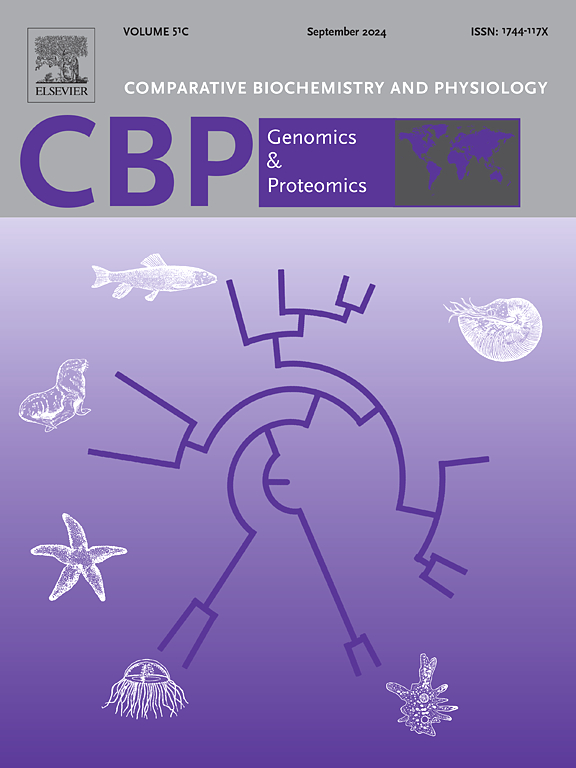多器官转录组学研究洞庭湖鲫鱼生长调控机制
IF 2.2
2区 生物学
Q4 BIOCHEMISTRY & MOLECULAR BIOLOGY
Comparative Biochemistry and Physiology D-Genomics & Proteomics
Pub Date : 2025-05-16
DOI:10.1016/j.cbd.2025.101538
引用次数: 0
摘要
为了研究洞庭湖鲫鱼(Carassius auratus indigentiaus)生长性状的关键调控基因和通路,采用RNA-Seq技术对生长速度极快和生长速度极慢的两组洞庭湖鲫鱼幼鱼早期脑、肠和肌肉组织的转录组进行了测序。在脑、肠和肌肉中分别检测到65、184和130个差异表达基因(deg)。京都基因与基因组百科(KEGG)通路分析强调PPAR信号通路、胰岛素/PI3K/Akt/mTOR/FoxO/AMPK通路和蛋白质消化吸收通路对该物种的生长至关重要。根据转录组数据,鉴定出32个关键基因,主要参与细胞增殖和分化、生长、发育和代谢等过程。突出的例子是环amp响应元件结合蛋白5 (creb5b),叉头盒蛋白O1-A (foxo1a),转录因子ap -1样(jun),脂蛋白脂酶样(lpl),血管生成素样4 (angptl4)和egl 9同源3样(egln3)。本研究加深了对金莲生长速率变化的遗传因素和调控机制的认识,为进一步研究金莲生长调控机制提供了有价值的基础。本文章由计算机程序翻译,如有差异,请以英文原文为准。

Multi-organ transcriptomics provide insights into growth regulation in the Dongtingking crucian carp (Carassius auratus indigentiaus)
To investigate the key regulatory genes and pathways related to growth traits in the Dongtingking crucian carp (Carassius auratus indigentiaus), the transcriptomes of brain, intestine, and muscle tissues were sequenced at early juvenile stage using RNA-Seq from two groups with extreme growth rates (fast-growing and slow-growing). A total of 65, 184, and 130 differentially expressed genes (DEGs) were detected in the brain, intestine, and muscle, respectively. Kyoto Encyclopedia of Genes and Genomes (KEGG) pathway analysis highlighted that the PPAR signaling pathway, Insulin/PI3K/Akt/mTOR/FoxO/AMPK pathway, and Protein digestion and absorption pathways are crucial for growth in this species. Based on the transcriptome data, 32 key DEGs were identified, mainly participating in processes such as cell proliferation and differentiation, growth, development, and metabolism. Prominent examples are cyclic AMP-responsive element-binding protein 5 (creb5b), forkhead box protein O1-A (foxo1a), transcription factor AP-1-like (jun), lipoprotein lipase-like (lpl), angiopoietin-like 4 (angptl4), and egl nine homolog 3-like (egln3). This study enhances the understanding of the genetic factors and regulatory mechanisms responsible for variations in growth rates and provides a valuable basis for further studies on the regulatory mechanisms of growth in C. auratus indigentiaus.
求助全文
通过发布文献求助,成功后即可免费获取论文全文。
去求助
来源期刊
CiteScore
5.10
自引率
3.30%
发文量
69
审稿时长
33 days
期刊介绍:
Comparative Biochemistry & Physiology (CBP) publishes papers in comparative, environmental and evolutionary physiology.
Part D: Genomics and Proteomics (CBPD), focuses on “omics” approaches to physiology, including comparative and functional genomics, metagenomics, transcriptomics, proteomics, metabolomics, and lipidomics. Most studies employ “omics” and/or system biology to test specific hypotheses about molecular and biochemical mechanisms underlying physiological responses to the environment. We encourage papers that address fundamental questions in comparative physiology and biochemistry rather than studies with a focus that is purely technical, methodological or descriptive in nature.

 求助内容:
求助内容: 应助结果提醒方式:
应助结果提醒方式:


